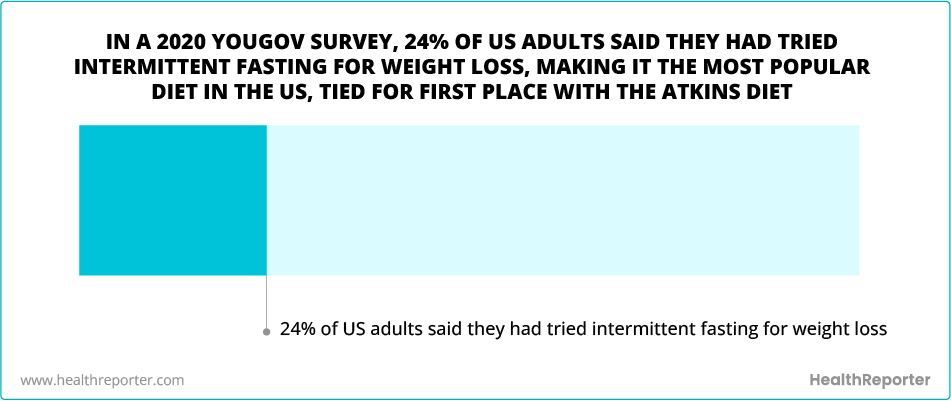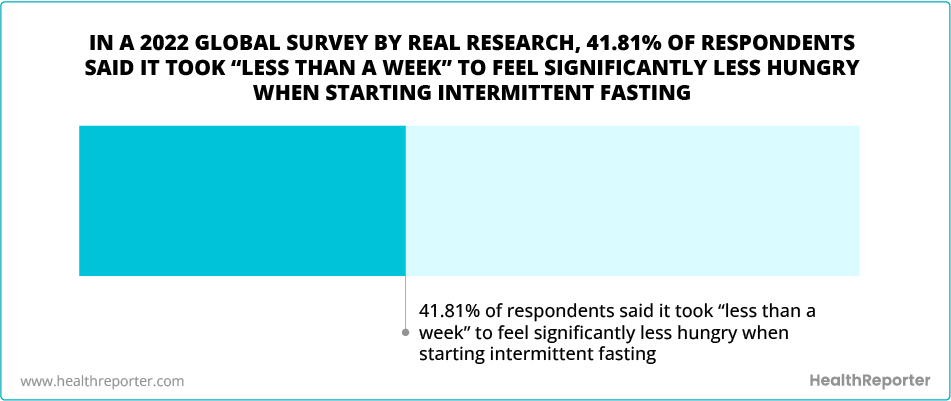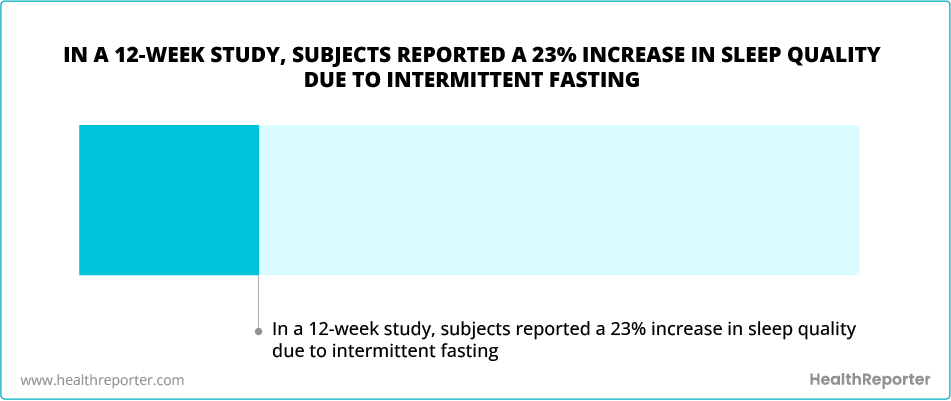34 Intermittent Fasting Statistics and Facts
We have been researching the increasing popularity and the effectiveness of intermittent fasting across the internet, on social media, and in reputable scholarly resources and have selected the most useful findings for you.

We have been researching the increasing popularity and the effectiveness of intermittent fasting across the internet, on social media, and in reputable scholarly resources and have selected the most useful findings for you.
Starting with popularity on social media, the habits of people following intermittent fasting and finishing with intermittent fasting’s effect on weight loss as well as general health and well-being.
What Is Intermittent Fasting?
Intermittent fasting is a form of time-restricted eating in which people (in most cases) stop consuming calories for an extended period of time or periodically significantly reduce their caloric intake.
There are a variety of ways to incorporate intermittent fasting into your life.
Some of them are time-restricted, where you fast for a certain amount of time and “feast” the rest of the day.
This includes the popular 12:12, 14:10, and 16:8 fasting methods. Within these methods, people fast for 12, 14, or 16 hours respectively and use the remaining 12, 10, or 8 hours to consume their regular amount of calories.
While generally, it is advisable to consume nothing but water and zero-calorie beverages (such as coffee or tea) throughout the fasting period, some fasters make an exception for bone broth, lemon water, and, controversially, vegetable juices to curb cravings and make the fasting experience more pleasant.
Other popular methods of fasting include OMAD (One Meal A Day), the 5:2 diet, and alternate-day fasting.
OMAD is a pretty self-explanatory diet, which allows the faster to consume all of their daily calories in one sitting and refrain from eating for the rest of the day.
The 5:2 diet is a bit less extreme, allowing 5 days of regular eating and restricting caloric intake to 500–600 calories per day, 2 days out of the week (not necessarily consecutive!).
As the research suggests, all of these methods are equally effective, you just need to choose one that fits your lifestyle.
Key Fasting Statistics
- According to a new survey 80.17% of respondents had heard of intermittent fasting.
- In a 2020 survey, 24% of US adults said they had tried intermittent fasting for weight loss, making it the most popular diet in the US, tied for first place with the Atkins diet.
- Intermittent fasting studies longer than 4 weeks have recorded a 1.18 to 3.15-inch decrease in waist circumference in participants.
- A systematic review of 40 studies found that intermittent fasting was effective for weight loss, with a typical loss of 7–11 pounds over 10 weeks. There was much variability in the studies, ranging in size from 4 to 334 subjects and followed from 2 to 104 weeks.
- In a 2022 global survey 41.81% of respondents said it took “less than a week” to feel significantly less hungry when starting intermittent fasting.
- Intermittent fasting is an effective non-medical treatment for diabetes, reducing body weight, decreasing fasting glucose levels by an average of 4.16mg/dL, decreasing fasting insulin, and reducing insulin resistance.
- Fasting improves bone health by affecting hormones involved in bone metabolism and remodeling processes.
- Fasting improves mood, quality of sleep, alertness, and sense of peacefulness.
- In a 12-week study, subjects reported a 23% increase in sleep quality due to intermittent fasting.
Intermittent Fasting Popularity and Convenience
Intermittent fasting is one of the most popular health trends of the 21st century.
This form of eating appeals to many people because of its simplicity. It doesn’t require diet-specific meal plans, complicated calorie and macro counting, or cutting out entire food groups. This makes intermittent fasting flexible and easily adaptable to any lifestyle.
There are a variety of reasons people practice intermittent fasting – some of them are health-related, including weight management, increasing longevity, and improving heart health and immunity, while others are culturally and religiously motivated, such as Ramadan or fasting during Lent.
Here are some statistics and facts about how intermittent fasting is followed by people worldwide and portrayed in the media:
- In 2019, “intermittent fasting” was the most googled food-related topic globally. While it has been overtaken by keto in 2020 and 2021, it remains one of the most popular searches.
- There are nearly 7 million posts under the hashtag #intermittentfasting on Instagram.
- In a global survey conducted in 2022, 80.17% of respondents had heard of intermittent fasting.

- Compared to other diets, people are more likely to say intermittent fasting is an inexpensive dieting option rather than expensive (80% vs. 18%, respectively).
- 42.99% say their fasting schedule involves fasting for 16–23 hours.
- A variety of celebrities and public figures have boasted the benefits of intermittent fasting, including Jennifer Anniston, Nicole Kidman, Hugh Jackman, Reese Witherspoon, Halle Berry, Nicole Kidman, Margot Robbie, Elsa Pataky, Kourtney Kardashian, Jennifer Lopez, Giselle Bündchen, Elsa Pataky, Scarlett Johansson, Vanessa Hudgens, and Mindy Kaling.
- Jennifer Anniston follows an imperfect 16:8 intermittent fasting regime, where she has celery juice for breakfast while still fasting. She says it’s made “a big difference <…> going without solid food for 16 hours.”
- Both Nicole Kidman and Hugh Jackman have been reported to follow a 16:8 intermittent fasting protocol, breaking their fast at 10 AM and resuming it at 6 PM.
Sources: Insider, Instagram, Marie Claire, NZHerald, People, Real Research Media, Radio Times, YouGov.
Intermittent Fasting and Weight Loss
The majority of people who try to incorporate intermittent fasting into their lives tend to do so because they want to lose weight or reap the benefits of weight loss.
While intermittent fasting might only be one option in a boundless selection of diets, meal plans, and other approaches to maintaining a healthy eating regime, it has its own unique set of benefits, such as increased energy levels, better coping with cravings, and is universally seen as an effective way to combat obesity and weight issues.
Here are some facts and statistics about the link between intermittent fasting and weight loss:
- Intermittent fasting is an effective way to treat obesity.
- In a 2020 YouGov survey, 24% of US adults said they had tried intermittent fasting for weight loss, making it the most popular diet in the US, tied for first place with the Atkins diet.

- Compared to WeightWatchers, the Atkins diet, keto, the Mediterranean diet, and vegetarianism, most people (50%) claimed that intermittent fasting has been highly effective for their weight loss efforts.
- Almost any intermittent fasting regimen will result in weight loss. Whether 16:8 or 5:2 better fits your schedule, you’ll still see the results you’re looking for.
- The three most popular forms of intermittent fasting (alternate-day fasting, the 5:2 diet, and time-restricted eating) produce mild to moderate weight loss (3–8% loss from baseline) over short durations (8–12 weeks).
- Almost 9 in 10 (87%) people who have tried intermittent fasting to lose weight say that this diet was very effective (50%) or somewhat effective (37%) in helping them lose weight.
- Intermittent fasting studies longer than 4 weeks have recorded a 1.18 to 3.15-inch decrease in waist circumference in participants.

- While a combination of exercise and alternate-day fasting is the most effective for reducing fat mass and waist circumference, alternate-day fasting is more effective than exercise for weight loss. In a 2013 randomized controlled trial, the alternate-day fasting group lost on average 3 times more weight than the exercise group.
- A systematic review of 40 studies found that intermittent fasting was effective for weight loss, with a typical loss of 7–11 pounds over 10 weeks. There was much variability in the studies, ranging in size from 4 to 334 subjects and followed from 2 to 104 weeks.

- Intermittent fasting regimes lead to metabolic adaptations that help induce a greater loss of fat mass, preserve lean mass, and increase the ability to sustain weight loss.
- A study done in 2016 found that participants who maintained an intermittent fasting regime regained weight in lean body mass, rather than both fat and lean body mass, which was the pattern of calorie-restricted patients.
- Short-term studies suggest that people stick to intermittent fasting diets as well as or better than they do to other diets.
- In a 2022 global survey by Real Research, 41.81% of respondents said it took “less than a week” to feel significantly less hungry when starting intermittent fasting.

- Intermittent fasting studies generally find that hunger levels remain stable or decrease during IF.
- Hunger levels are affected by intermittent fasting modifying appetite-regulating hormones, which curbs cravings.
Sources: Annual Reviews, Harvard Health Publishing, National Library of Medicine 1, National Library of Medicine 2, National Library of Medicine 3, National Library of Medicine 4, Nature 1, PubMed 1, PubMed 2, Real Research, YouGov.
Intermittent Fasting and Medical Conditions
While the overwhelming majority of intermittent fasting is done for weight loss, studies show that it can also be used to treat symptoms of various health conditions, improve overall health and immunity, and combat mental illness.
Though extensive human trials for intermittent fasting effects have been sparse so far, there is a lot more evidence from research based on animals that suggest extensive health benefits.
Even at this early stage of research, intermittent fasting has proven to have positive effects on a variety of diseases and illnesses. Here are some of the benefits of intermittent fasting for dealing with medical conditions, based on research done with humans:
- Studies suggest that intermittent fasting is not harmful physically or mentally in healthy, normal weight, or obese adults. Therefore, next time you’re wondering whether intermittent fasting is going to disrupt your metabolism or cause issues with your mood – don’t fret, you’re safe!
- Fasting can slow down the growth of tumors.
- Fasting protects normal cells in humans from the harmful side effects of a variety of chemotherapy drugs.
- According to a 2019 review article in the journal Nutrients, intermittent fasting promotes weight loss and may reduce risk factors linked to heart disease, including diabetes, high blood pressure, unhealthy blood lipid levels, and inflammation.
- Intermittent fasting studies with both diabetic and non-diabetic subjects have shown a reduction in cardiovascular risk factors.
- A study conducted on women with PCOS has found that fasting eases PCOS symptoms, improving both the women’s mental and physical health.
- Intermittent fasting is an effective non-medical treatment for diabetes, reducing body weight, decreasing fasting glucose levels by an average of 4.16mg/dL, decreasing fasting insulin, and reducing insulin resistance.

- Fasting improves bone health by affecting hormones involved in bone metabolism and remodeling processes.
- Fasting has a positive effect on mental health by improving mood, quality of sleep, alertness, and sense of peacefulness.
- In a 12-week study, subjects reported a 23% increase in sleep quality due to intermittent fasting.

- Patients participating in intermittent fasting studies reported improved body image and less depression.
- Even though more research on humans is needed, intermittent fasting may be linked to greater longevity.
Sources: Annual Reviews, BMC, Harvard Health Publishing, National Library of Medicine 1, National Library of Medicine 5, National Library of Medicine 6, Nature 2, PubMed 3, PubMed 4, Women’s Health Bulletin.

















































 Select your language:
Select your language: 








